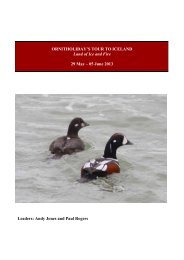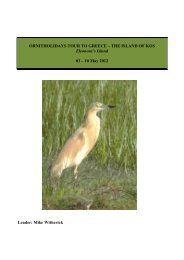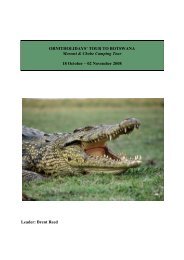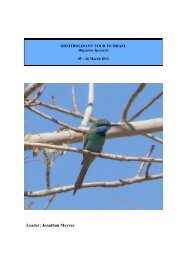Download 2014 Brochure (.pdf) - Ornitholidays
Download 2014 Brochure (.pdf) - Ornitholidays
Download 2014 Brochure (.pdf) - Ornitholidays
You also want an ePaper? Increase the reach of your titles
YUMPU automatically turns print PDFs into web optimized ePapers that Google loves.
U G A N D A<br />
Uganda<br />
Birds & Primates<br />
Sunday 06 July – Friday 18 July <strong>2014</strong><br />
Leaders: Nigel Jones and Harriet Kemigisha<br />
<strong>2014</strong> Cost £4,499 single room supplement £250<br />
Queen Elizabeth<br />
National Park<br />
Bwindi Impenetrable<br />
Forest<br />
Fort Portal<br />
Kibale Forest<br />
National Park<br />
Lake Mburo<br />
National Park<br />
UGANDA<br />
Kampala<br />
Entebbe<br />
Lake<br />
Victoria<br />
T<br />
his country of forests, lakes and mountains sits astride the Equator and combines influences from<br />
eastern and central Africa. The great beauty of Uganda led Sir Winston Churchill to call it “the Pearl of Africa”. On this tour we travel to the forests<br />
of Kibale, then to the open savannah of the Queen Elizabeth National Park, and finally visit the great Impenetrable Forest of the south-west. For a small<br />
country, Uganda holds an unrivalled variety of primates and is currently one of the few places in the world where Mountain Gorillas can be seen fairly<br />
easily. Bwindi’s Impenetrable Forest is home to these magnificent creatures and (for those who wish to) we can spend a day tracking them through<br />
the dense forest. To observe them from just a few metres, as they go about their daily routine of sleeping, grooming and feeding is probably the<br />
ultimate thrill of a lifetime. During our time at Kibale we may also have a chance to see our other close relative – the Chimpanzee. Our itinerary this<br />
year allows for a longer stay in the Kibale area so we can track down more of the Albertine Rift endemic species. Throughout the tour we shall have<br />
the services of Harriet Kemigisha, who has co-led our last few tours to this country and whose assistance has proved invaluable with her extensive<br />
knowledge of the calls and habits of many of Uganda’s more elusive species. This will be <strong>Ornitholidays</strong> ninth tour to Uganda.<br />
Mountain Gorilla<br />
ITINERARY<br />
Days 1 & 2<br />
We take an evening flight from London to<br />
Entebbe where we arrive the next morning. We<br />
visit the Mabamba Swamp where we start to see<br />
our first African birds. We take small boats into<br />
the reed-fringed channels and look for the<br />
diminutive but colourful Malachite Kingfisher,<br />
Swamp Flycatcher, Blue-breasted Bee-eater and<br />
White-winged Warbler. This swamp also gives us<br />
the chance to see one of Africa’s most soughtafter<br />
birds – the Shoebill. This large bird with an<br />
enormous beak is uncommon throughout its<br />
restricted range but we hope to be lucky here<br />
today (as we have always been on previous<br />
trips). We then travel to Fort Portal where we<br />
stay overnight.<br />
Days 3 & 4<br />
We can spend the morning birding in the<br />
Semuliki National Park, an area of lowland<br />
rainforest and excellent for birding – interestingly<br />
it holds many species which are also commonly<br />
found in West Africa, and we can look for Black<br />
Dwarf and Piping Hornbills, African Piculet,<br />
Rufous-sided Broadbill, Maxwell’s Weaver and<br />
Blue-throated Roller. We then make the drive to<br />
the Kibale National Park rainforests. We have two<br />
nights here and on one morning we will track the<br />
Chimpanzees in this forest; the Kibale Forest is<br />
an extensive forest block of 560 sq kms and it is<br />
here that we could see Yellow-billed, Hairybreasted<br />
and Yellow-spotted Barbets, Yellowbill,<br />
Nahan’s Francolin, White-bellied Crested<br />
Flycatcher, Masked and Black-capped Apalis,<br />
White-naped Pigeon and perhaps a Greenbreasted<br />
Pitta. Here, also, the local community<br />
runs Bigodi wetland, an excellent place for<br />
seeing White-spotted Flufftail, Papyrus Gonolek,<br />
the elusive White-winged Warbler and Papyrus<br />
Canary. Other birds that we are likely to<br />
encounter include Purple-headed Glossy<br />
Starling, Blue-headed Coucal, Petit’s Cuckoo-<br />
Shrike, Green-headed and Green-throated<br />
Sunbirds, Black Bee-eater and perhaps the<br />
majestic African Crowned-Eagle. Kibale is a<br />
good place for Red Colobus Monkey as well as<br />
Grey-cheeked Mangabey, Black-and-White<br />
Colobus, and Blue and Peter’s Forest Duikers<br />
are infrequently encountered.<br />
Days 5 & 6<br />
Today we transfer to the Queen Elizabeth<br />
(Ruwenzori) National Park for a two-night stay.<br />
The QENP is a relatively small park, only 2,000<br />
sq kms, but due to its diversity of habitats, an<br />
astounding 535 bird species have been<br />
recorded here. The park has a wide range of<br />
habitat types, including an extensive area of<br />
crater lakes. Giant Forest Hog are frequently<br />
encountered during the day and Topi, Spotted<br />
Hyena, Leopard and Lion are all found here. On<br />
our launch trip on the Kasinga channel we may<br />
find Gull-billed Tern, African Skimmer, Spurwinged<br />
Lapwing, the majestic Goliath Heron and<br />
the brightly coloured Yellow-billed Stork, aside<br />
from numerous waders and Whiskered Tern.<br />
Hippopotamus are common here and along the<br />
shore we should also see Buffalo, Elephant and<br />
Uganda Kob. On our game drives we hope to<br />
see Papyrus Gonolek, Red-headed Lovebird,<br />
54<br />
For a previous tour report or further information please call: 01794 519445








